What is Instatus?
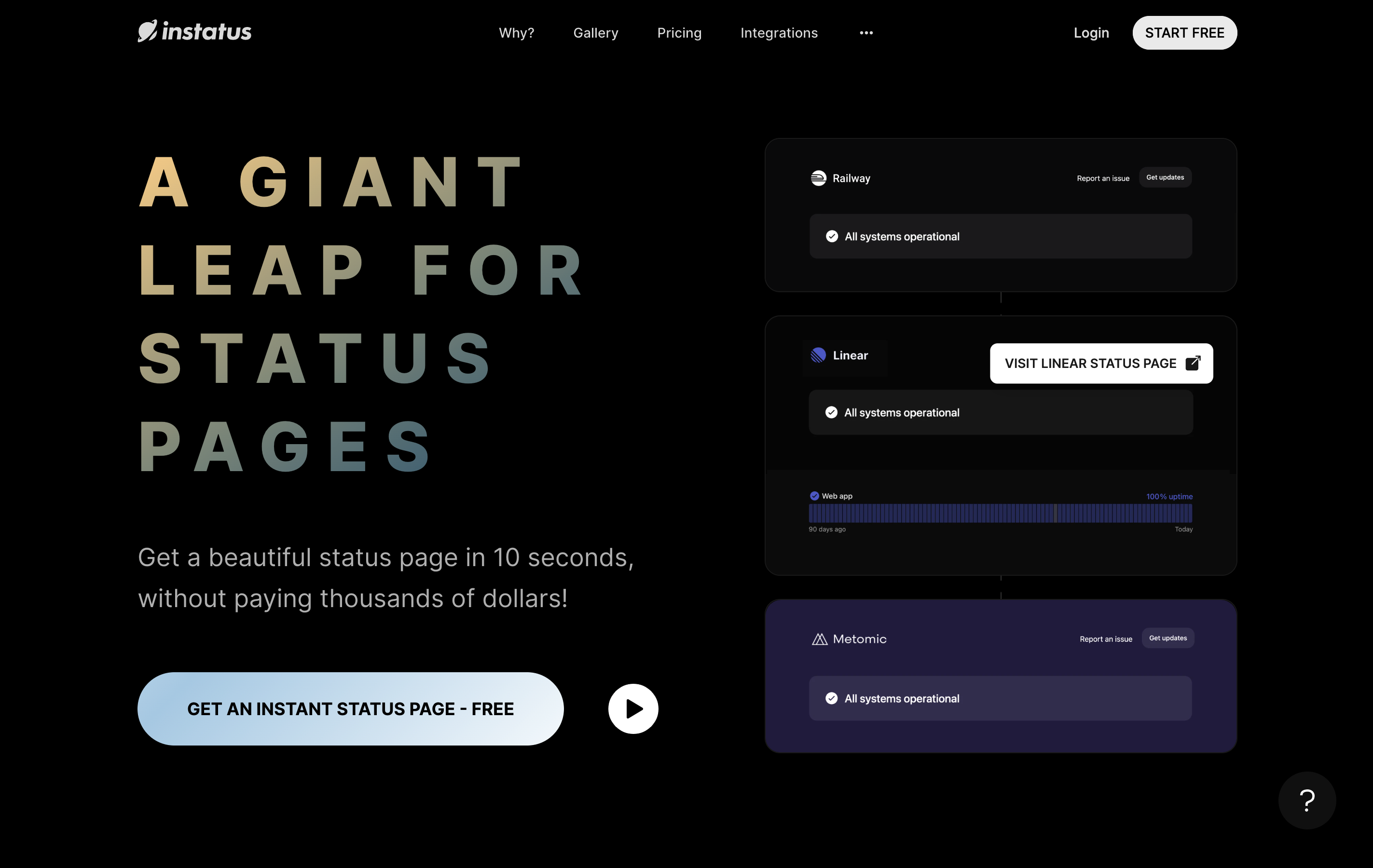
With over 19,000 users at the moment, Instatus is one of the most accessible status page providers today. It offers:
- a free status page plan
- unlimited subscribers
- a status widget for your website
- and integration with incident management tools like Checkly to automate your public status page.
Instatus is also one of the cheapest status page providers. However, if you want your status page on a custom domain you will have to pay $20 a month. Instatus charges additionally for a private status page too.
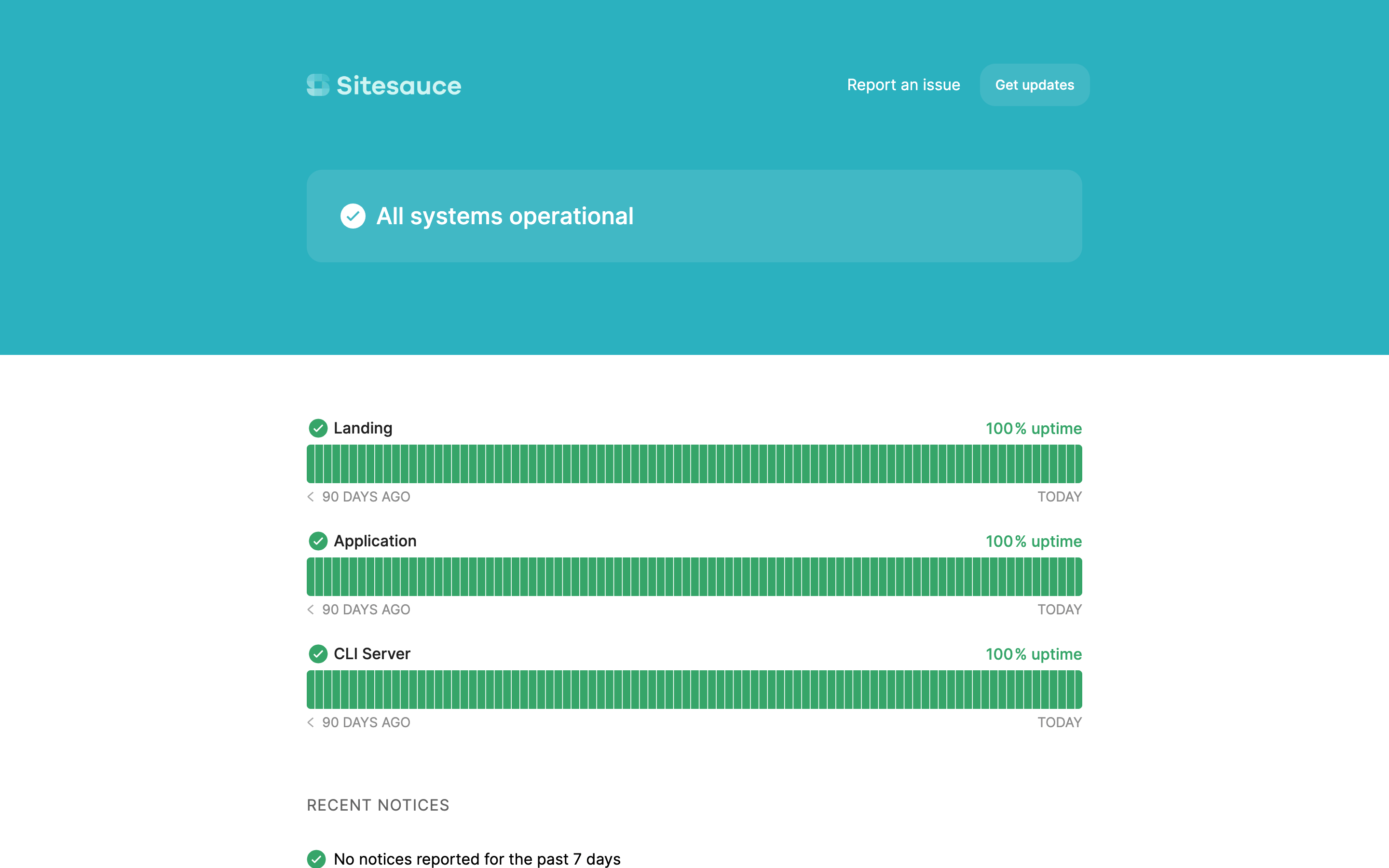
Overall, Instatus caters to growing teams with its reasonable pricing for a status page, where you do not have to pay for an upper-tier plan when you need more subscription slots to your status page or more team members to access the system.
Instatus is a good service, but some alternatives to Instatus can offer you more.
For example, StatusGator features status monitoring of 2,800+ cloud services, and users can add these statuses to their own status pages to display if any of their dependencies are down. No other status page provider does it.
Here’s a list of the Instatus alternatives and differences to consider.
#1 Instatus Alternative – StatusGator
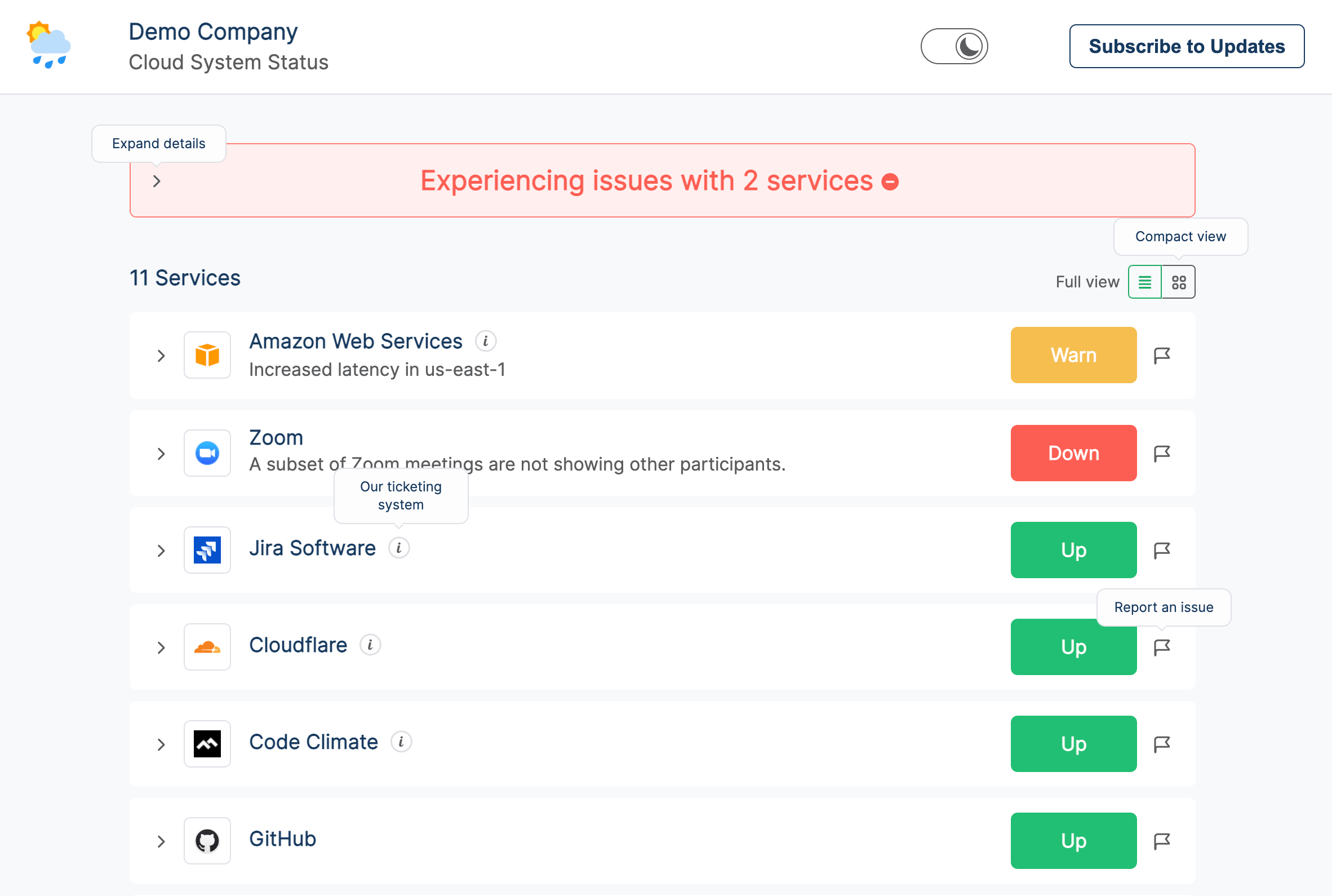
StatusGator tops this list of Instatus alternatives for a very good reason. When compared to other Instatus competitors, StatusGator is the only provider that gives your team a unified status page aggregating the status of all of your cloud vendors, hosted applications, services, websites, and more.
With a StatusGator plan, you can have a functional status page for your service, but also monitor the status of your internal services, and external services that your system depends on like AWS, Cloudflare, Azure, etc.
StatusGator enables a faster response to incidents including times when not your own product, but the service it depends on goes down. Meaning you can save so much time instead of trying to figure out what went wrong.
Once something goes wrong, you get an instant notification about the change of status and a detailed explanation of the issue. It is the perfect tool for IT, and DevOps teams in a variety of spheres, including K12 system admins to keep the support tickets burden under control.
StatusGator vs. Instatus
StatusGator’s unique offer – monitoring external services on your status page is not offered by Instatus.
With StatusGator you can embed your status page on any other web page with an iframe and display the status of your critical services.
Overall, StatusGator is more expensive than Instatus with four plans ranging from free to $299 monthly, with the additional option to get a custom plan. But the service is worth the price with its unique features.
Benefits of StatusGator
- Effective status page aggregator that saves time and money
- Option to subscribe to the status of only selected features of a service
- The ability to filter components of service by product, features, or region
- Built-in website monitoring
- Weekly reports
- Two-factor page authentication and single sign-on options
- Customizable status pages.
#2 Instatus Alternative – Status.io
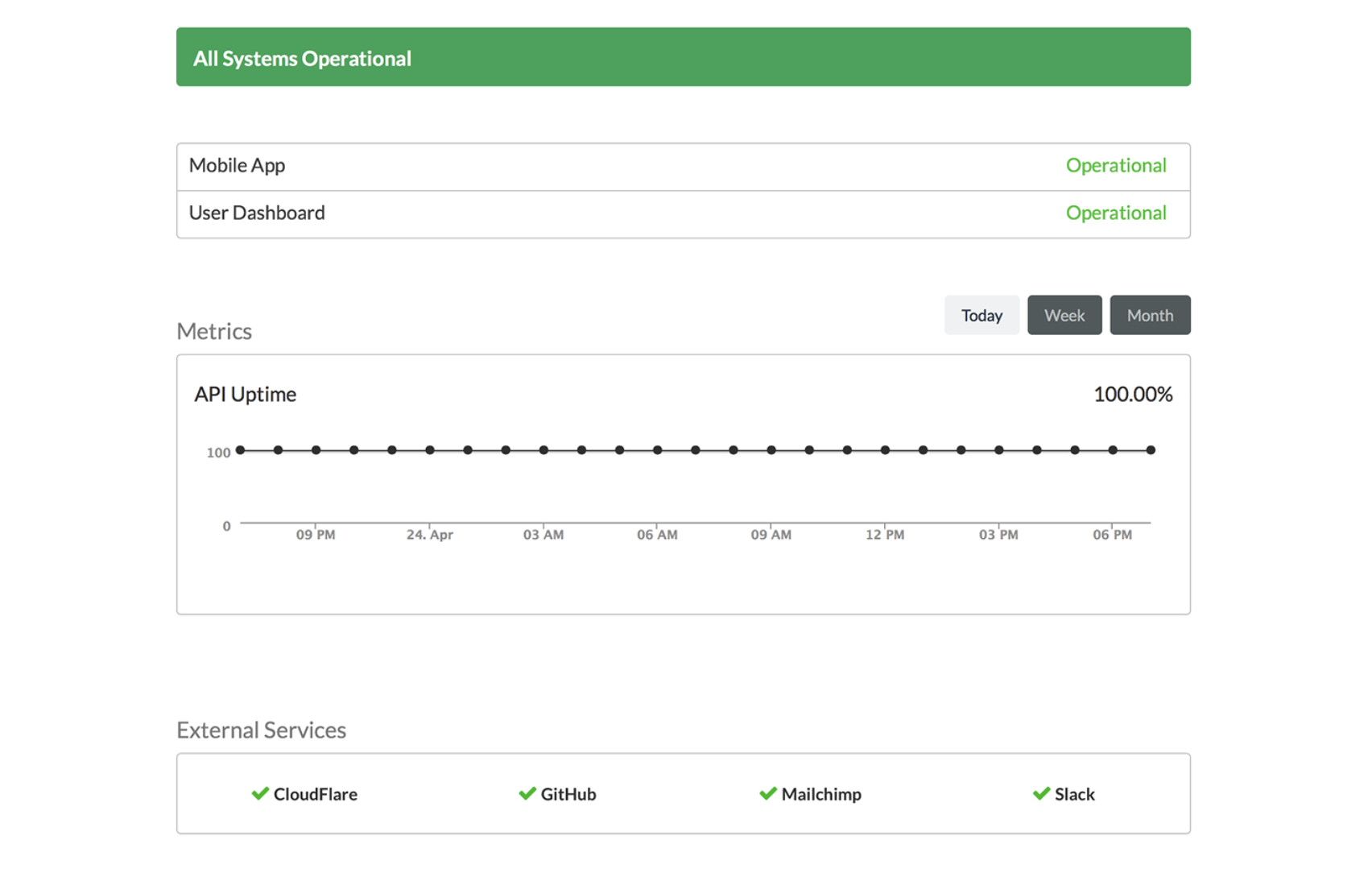
Status.io is a hosted system of status pages designed to support complex systems and multi-tenant infrastructure. Status.io is hosted redundantly offsite to ensure you and your users can always rely on your status page during outages.
Status.io’s infrastructure is spread across different continents and is powered by multiple providers, ensuring its availability. Therefore, with the Status.io status page, you get effective incident tracking, instant subscriber notifications that can be broadcasted, and a display of performance monitoring metrics.
The systems are also monitored by humans 24/7. Status.io system relies on hot and cold sites that are controlled by DNS failovers in the unlikely case of a global disaster.
Naturally, the status pages offered by Status.io are highly customizable, with a custom domain and DNS for your status page. Finally, with Status.io, you get an extra status page for testing.
Status.io vs Instatus
Status.io’s infrastructural setup is more advanced and a lot more disaster-proof than Instatus’, however, the paid plans are more expensive than the Instatus paid plans.
Status.io also affords its users the flexibility of managing all status pages from a single account, although each status page is still billed separately and remains autonomous.
Benefits of Status.io
- Private status pages can be set up with SSO and OIDC
- API integration in Go, Node.js, PHP, Python, and Ruby
- Subscribers can limit notifications to specific service components
- Existing monitoring tools like OpsGenie and New Relic can be linked to the service
- All plans include IPv6 and customizable domains
#3 Instatus Alternative – Uptime Robot
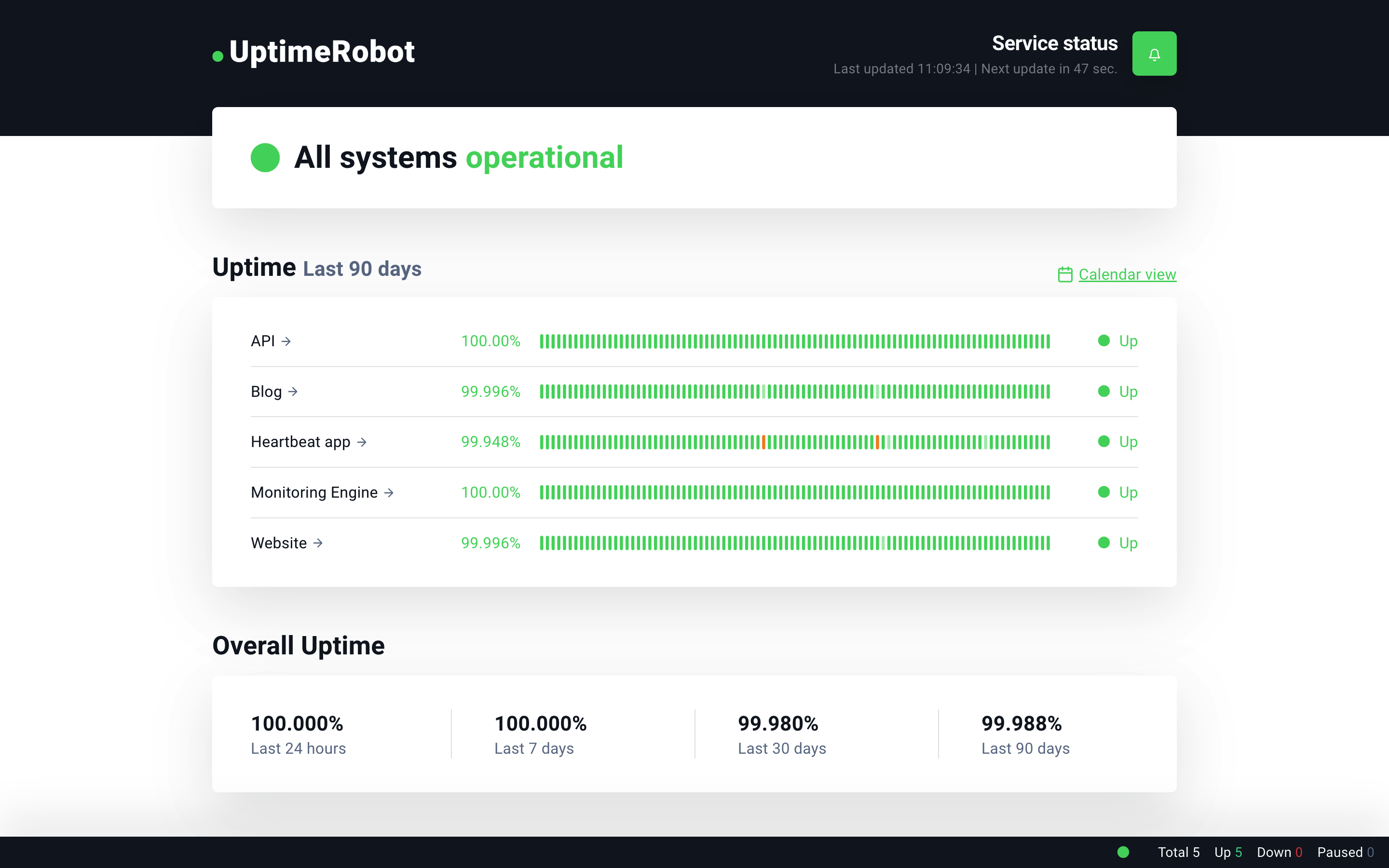
Uptime Robot offers a status page that can be an alternative to Instatus. However, Uptime Robot is a well-known monitoring service first. If you are interested in monitoring software apart from the status page, UptimeRobot’s services are split into different categories like website monitoring, SSL monitoring, keyword monitoring, also cron job, port, and ping monitoring.
A combination of all UptimeRobot offers provides you with an effective monitoring service. Uptime Robot also verifies incidents from different locations to prevent false positives or false negatives.
Like many Instatus competitors, Uptime Robot offers a free plan that includes 50 monitors without a status page. However, full-featured status pages become available with the Team plan for $29 monthly.
Uptime Robot vs. Instatus
Unlike Instatus, Uptime Robot is more focused on providing uptime monitoring while status pages are only a secondary product that comes with some of the paid plans.
Benefits of Uptime Robot
- A money-back guarantee for first-time paying users
- Maintenance windows setup for planned maintenance
- Performance evaluation with response time metrics
# 4 Instatus Alternative – Upptime
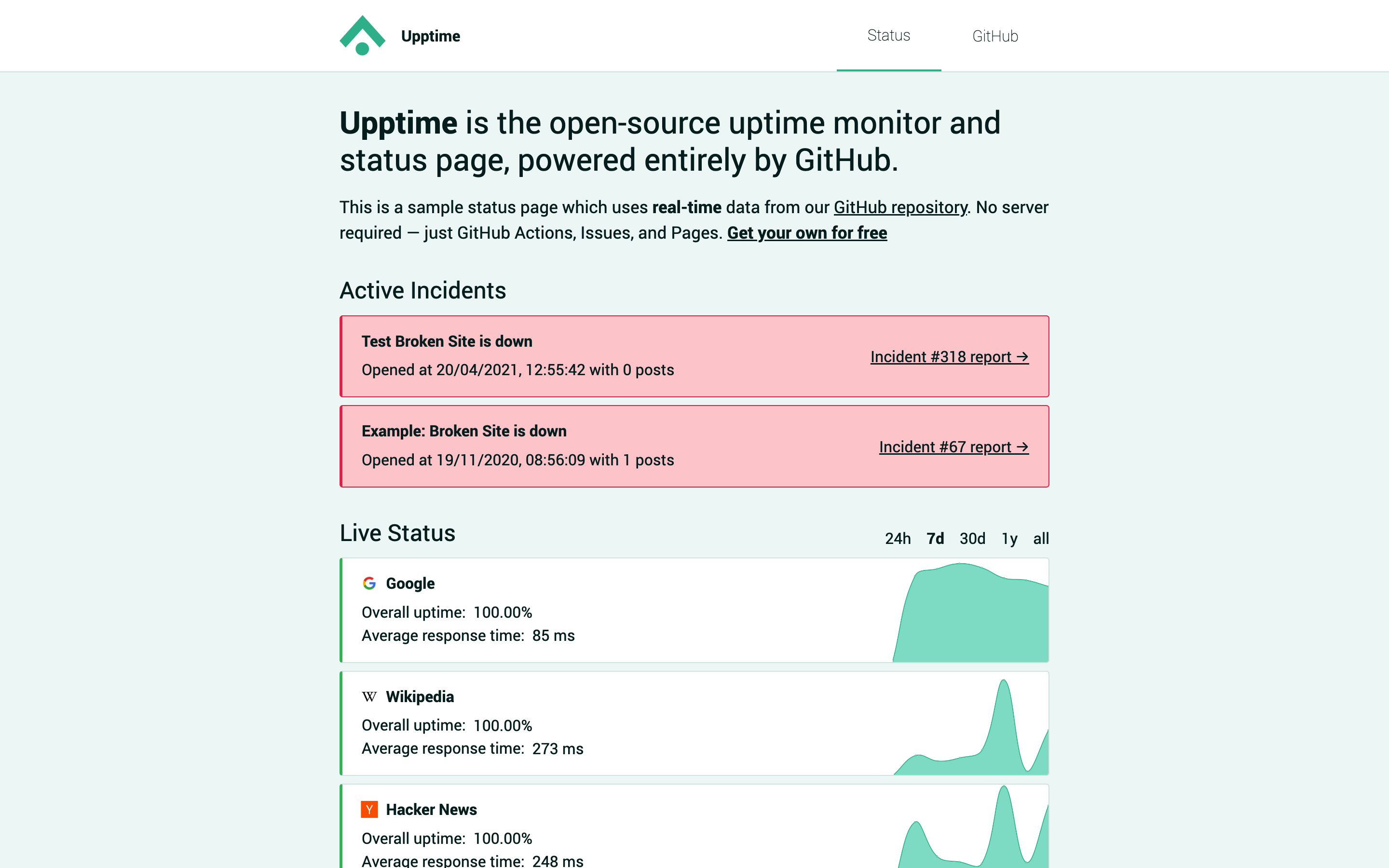
Unlike all of the other Instatus alternatives, Upptime is the first open-source option that provides a status page and uptime monitoring. The service relies on real-time data from the GitHub repository to provide incident reports. To use the service, users do not need to rely on a server, but will only require knowledge of relevant GitHub Actions, Issues, and Pages.
With Upptime, each user can configure the intervals at which they want Upptime to run checks on their website, with the shortest interval permitted being 5 minutes. Once the service checks the status of the website at each interval, it reports the status. With GitHub Actions, you can monitor as many web pages as you want.
The service also offers a GitHub repository that allows you to generate daily graph images of your response times. This feature could be especially helpful for performance evaluation. Other packages you can get with Upptime include a GitHub template, a highly customizable status page, and a monitor.

Upptime vs. Instatus
Since Upptime is an open-source service, it is mostly free (you have to pay to use a private repository). And if you are comfortable with GitHub, it can provide you with all of the basic features you’d need from a monitoring and status page service. You can also tweak the service to suit any unique needs you might have.
Benefits of Upptime
- The open-source but does not require hosting
- Instant notifications over multiple channels
- Monitor unlimited web pages
# 5 Instatus Alternative – Statuspage.io

Atlassian-owned Statuspage.io promises to help you build trust among your users by providing effective communication at every stage during incident management. This service allows you to integrate all your other monitoring, chat, alerting, and helpdesk tools to improve and automate communication with your users once an issue is detected.
Statuspage.io lets you show a history of uptime on your page which could serve as a marketing tool to prospective and existing customers. One of the more impressive features of Statuspage.io is its ability to help you create a more streamlined process during incident management with proactive customer communication that eliminates duplicate support tickets.
Statuspage.io vs. Instatus
As an Instatus competitor, Statuspage.io can be described as overall being a better fit for bigger teams or bigger organizations.
Apart from monitoring the internal status of your service and displaying it publicly, this Instatus competitor supports monitoring over 150 third-party components that your business might rely on like Shopify or Stripe.
Benefits of Statuspage.io
- It is the perfect alternative for big teams
- The proactive communication system reduces ticketing
- You can create different status page views for different viewers
- Website widgets display to show active incidents or scheduled maintenance
# 6 Instatus Alternative – Better Uptime
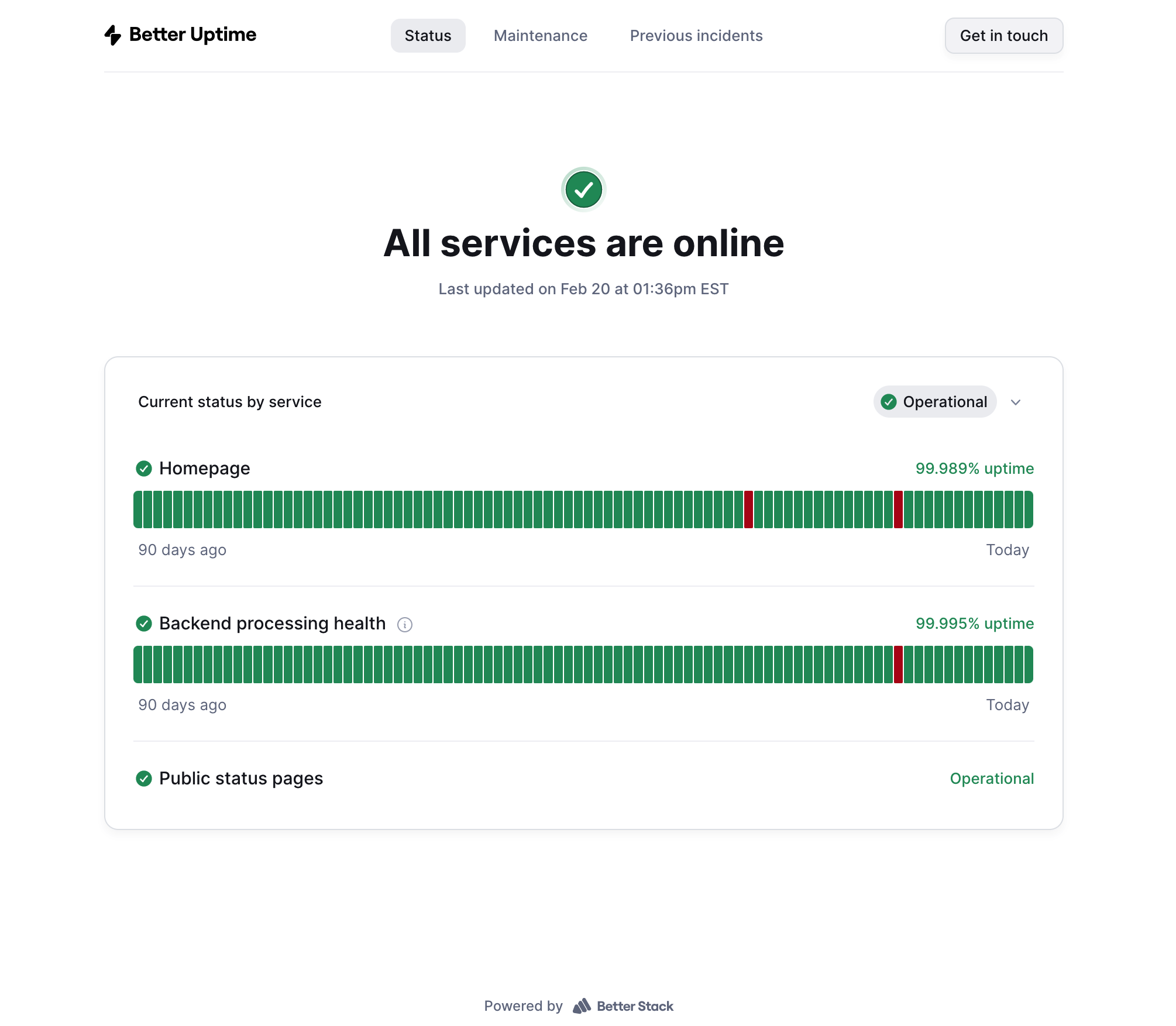
With Better Uptime, you get uptime monitoring with 30-second checks and status pages. In addition to monitoring your services and components, Better Uptime also offers infrastructure monitoring to help you keep an eye on things like your database backup, server RAM, and more.
For effective incident management, the service provides on-call alerting to notify the appropriate employee whenever an issue arises. You can also configure a system for escalating incidents within your team based on the nature of the incident. It means you can choose to alert the support team when certain issues arise, or the engineering team. Alerting could be via email, SMS, automated phone calls, Slack, Teams, or whatever platform that your team uses. Integrations can be done in minutes.
Better Uptime also provides you with an audit timeline to see how incidents started, how they progressed, and when they were resolved. This could serve as a tool to gauge your team’s performance and response times subsequently. This alternative also offers advanced access management.
Better Uptime vs. Instatus
Like Instaus, Better Uptime offers a free plan with a basic status page with all the essential features, 10 monitors, and 5 status pages. As an Instatus alternative, they stand out with an efficient alerting system and infrastructure monitoring, however, the free plan does not allow for unlimited team members. Plus, Better Uptime integrates with Status Gator, adding up functionality to its status page.
Some of its paid plans offer more security with role-based access control and SSO.
Benefits of Better Uptime
- A second-by-second incident timeline
- Multi-team collaboration for incident management is made easier
- 5 unique status pages with the free plan
- Custom sub-domain with HTTP comes with all plans
# 7 Instatus Alternative – Cachet
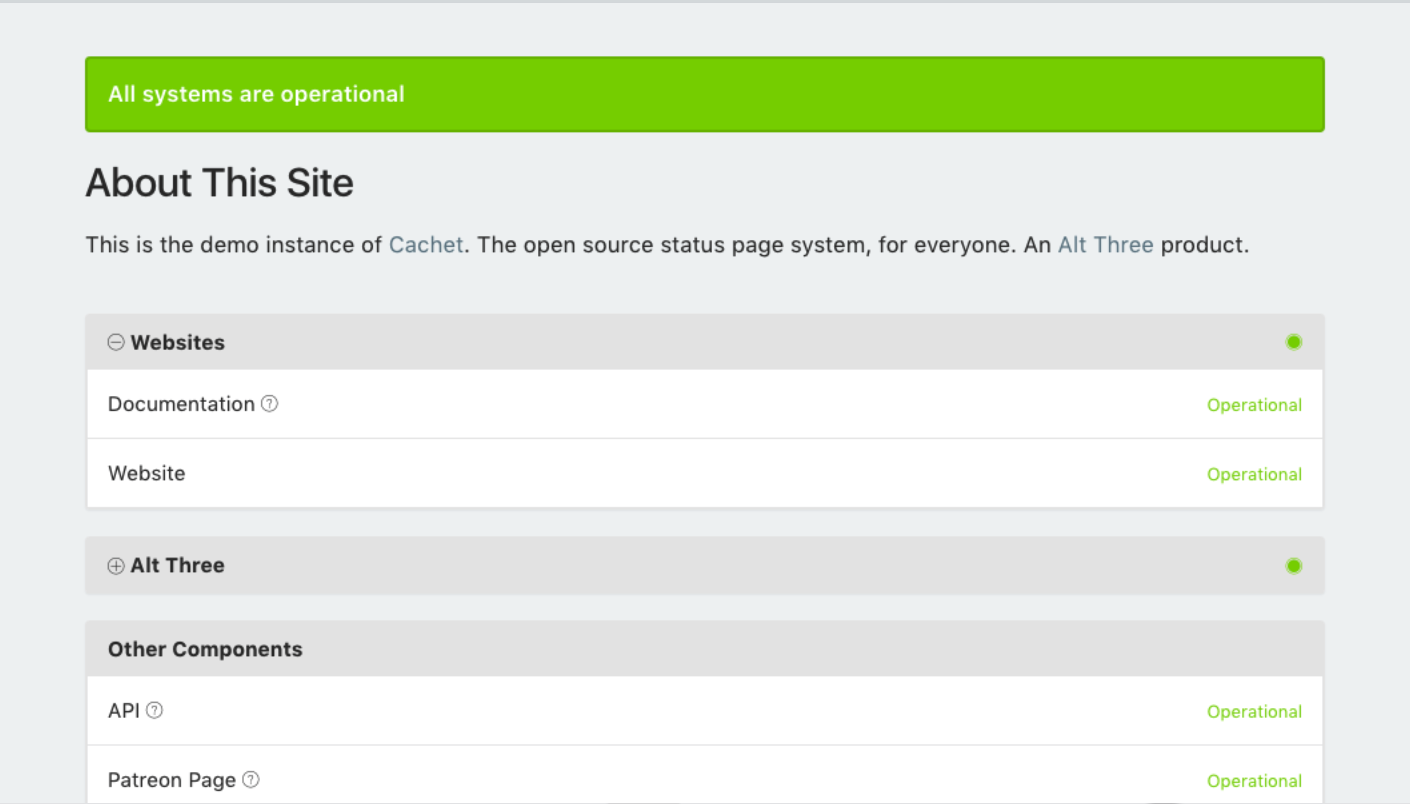
Another alternative to Instatus is Cachet. It is an open-source status page system built using Bootstrap 3. Impressively, Cachet provides support in over ten languages for users who might not understand English.
Like many of the alternatives to Instatus that we’ve covered here, Cachet provides an uptime monitor, scheduled maintenance, and security features like 2FA compatible with the Google Authenticator.
Cachet also comes bundled with JSON API to allow manual updates of a status page for internal services and dependencies.
Cachet vs. Instatus
Cachet might not be the best option for individuals since its open-source nature makes it more technical to operate and understand. But on the other hand, the fact that it is open source makes it customizable to suit unique needs.’
The Cachet dashboard is very impressive, and there is a Slack community you can rely on for support.
Benefits of Cachet
- Free but you might have to pay for installation and other add-ons
- Highly customizable
- Comes with JSON API bundled
- You can set up metrics to track almost anything on your dashboard
- Support is available in multiple languages.
Comparing Instatus Alternatives Side-by-Side
| Criteria | StatusGator | Statuspage | Better Uptime | Cachet | Instatus | Status.io | UptimeRobot | Upptime |
|---|---|---|---|---|---|---|---|---|
| Primary category | communication, monitoring, aggregation | communication | monitoring | communication | communication | communication | monitoring | monitoring |
| Key differences | ||||||||
| Private status page | ✅ On all plans | From $79/month | From $200/month | ❓ | For $50/month | For $349/month | For $348/month | ❓ |
| Components display | ✅ | ✅ | ❓ | ✅ | ✅ | ✅ | ❓ | ❓ |
| Website monitoring | ✅ | ❌ | ✅ | ❌ | ❌ | ❌ | ✅ | ❌ |
| Monitoring - third-party service statuses | 2,800+ | 200 | ❌ | ❌ | 168 | 170 | ❌ | ❌ |
| Trial | ✅ | ❌ | ❌ | ❌ | Only on private pages | ❌ | ❌ | ❌ |
| Cost per month | Starts at $72 | Starts at $29 | Starts at $30 | Free | Starts at $20 | Starts at $79 | Starts at $7 | Free |
| Status page features | ||||||||
| Hosted | ✅ | ✅ | ✅ | self-hosted | ✅ | ✅ | ✅ | ✅ |
| Favicon | ✅ | ✅ | ❓ | ✅ | ✅ | ✅ | ❓ | ✅ |
| CSS | ✅ | On paid plans | ✅ | ✅ | ✅ | ✅ | ❓ | ✅ |
| Branding removal | ✅ | ❓ | ❓ | ❓ | ❓ | On Standard plan and higher | On PRO plan and higher | ❓ |
| Components display | ✅ | ✅ | ❓ | ✅ | ✅ | ✅ | ❓ | ❓ |
| Subscribers to status pages | Unlimited | Limited | Limited. Available on higher plans only | Unavailable | Unlimited | Limited. Quantity depends on the plan | Limited. Available on higher plans only | Unavailable |
| Notifications | Email, SMS, Slack, MS Teams, Discord | Slack email, Webhook | Voice call, SMS, Mobile pushSlack, Microsoft Teams | SMS, Discord Slack, Twitter, Micrisoft teams, email | Twitter, SMS, voice call, Email, Slack, Discord Telegram | Email, SMS, voice call, Slack, Zapier, Twitter | Slack, Telegram, Webhooks |
|
| Password protection | ✅ | On Starter plan and higher | On Business plan and higher | ✅ | On Private PRO plan and higher | Authentication via SSO, SAML Identity Providers, IP Access control | ❓ | ❓ |
| Monitoring | ||||||||
| Ping interval | 5 min | 30 sec | 3 min or 30 sec on Freelancer plan and higher | ❓ | ❓ | ❓ | 5 min or 1 min on PRO plan | 5 min |
| General | ||||||||
| Documentation | Great | Good | Good | Great | OK | OK | OK | Good |
| Support | Contact form, email, chat | Contact form | Email, chat, phone | Email, Help with installation $249 | Chat, email | Chat | GitHub | |
| Account security | 2FA, SSO | 2FA, G Suite and SAML single sign-on | 2FA, GDPR, SSO on Enterprise plan | 2FA | SSO / SAML on Business plan | 2FA with Yubikey,Custom TLS / SSL Certificate, IP filtering, | 2FA | ❓ |

FAQ on Instatus Alternatives
Q: What is the alternative to Instatus?
A: The best alternative to Instatus is StatusGator. Not only is StatusGator wonderful for small teams, but it also monitors and communicates the status of over 2,800+ services that your business may rely on, including cloud dependencies. With StatusGator, you can have all your bases covered – internally and externally.
Q: What is the best Instatus alternative?
A: Some of the best Instatus alternatives in terms of status page service are StatusGator and Status.io. StatusGator is currently the most powerful status aggregator product available to monitor and display the status of multiple services at once. Other alternatives are Statuspage.io and Better Uptime.
Q: What are Instatus’ Competitors?
A: Instatus competitors are products or platforms that offer a service similar to what Instatus provides. The best Instatus competitors in order are:
- StatusGator
- Status.io
- UptimeRobot
- Upptime
- Statuspage.io
- Better Uptime
- Cachet
Recent posts



